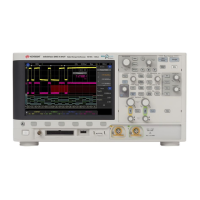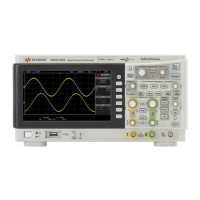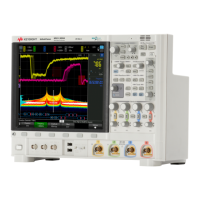248 Keysight InfiniiVision 3000T X-Series Oscilloscopes Programmer's Guide
8 :BUS<n> Commands
:BUS<n>:BITS
(see page 1276)
Command Syntax
:BUS<n>:BITS <channel_list>, <display>
<channel_list> ::= (@<m>,<m>:<m>, ...) where commas separate bits and
colons define bit ranges.
<m> ::= An integer, 0,..,15, defines a digital channel affected by the
command.
<display> ::= {{1 | ON} | {0 | OFF}}
<n> ::= An integer, 1 or 2, is attached as a suffix to BUS
and defines the bus that is affected by the command.
The :BUS<n>:BITS command includes or excludes the selected bits in the channel
list in the definition of the selected bus. If the parameter is a 1 (ON) then the bits in
the channel list are included as part of the selected bus definition. If the parameter
is a 0 (OFF) then the bits in the channel list are excluded from the definition of the
selected bus.
Query Syntax
:BUS<n>:BITS?
The :BUS<n>:BITS? query returns the definition for the specified bus.
Return Format
<channel_list>, <display><NL>
<channel_list> ::= (@<m>,<m>:<m>, ...) where commas separate bits and
colons define bit ranges.
<display> ::= {0 | 1}
See Also • "Introduction to :BUS<n> Commands" on page 246
• ":BUS<n>:BIT<m>" on page 247
• ":BUS<n>:CLEar" on page 250
• ":BUS<n>:DISPlay" on page 251
• ":BUS<n>:LABel" on page 252
• ":BUS<n>:MASK" on page 253
Example Code
' Include digital channels 1, 2, 4, 5, 6, 7, 8, and 9 in bus 1:
myScope.WriteString ":BUS1:BITS (@1,2,4:9), ON"
' Include digital channels 1, 5, 7, and 9 in bus 1:
myScope.WriteString ":BUS1:BITS (@1,5,7,9), ON"
' Include digital channels 1 through 15 in bus 1:
myScope.WriteString ":BUS1:BITS (@1:15), ON"
This command is only valid for the MSO models.

